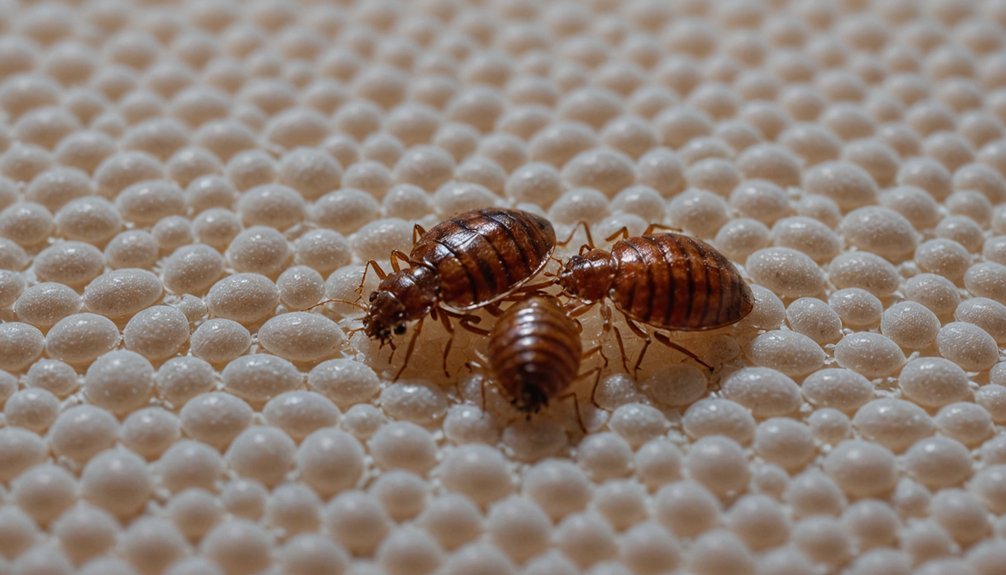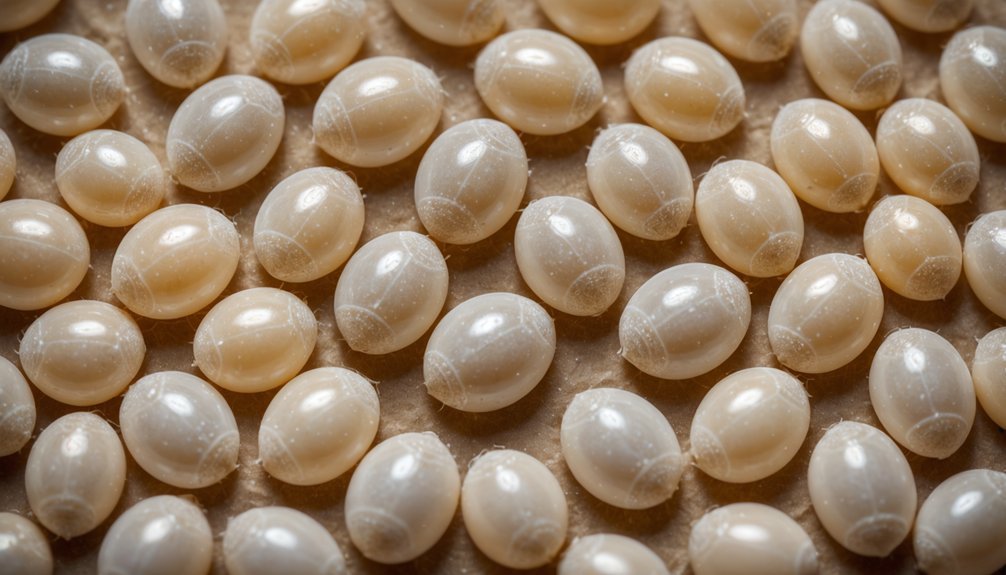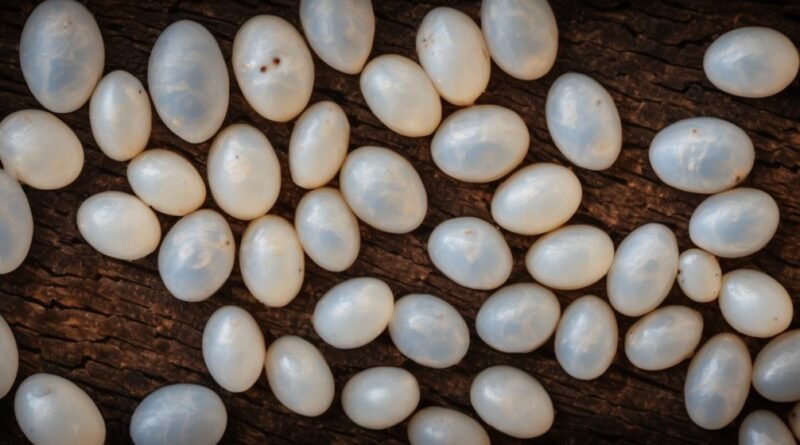Bed Bug Eggs: Size, Color & Where to Find Them
You’ll need a sharp eye and a systematic approach to spot bed bug eggs before they become a bigger problem. These tiny oval deposits, no larger than a grain of salt, can signal the start of a serious infestation in your home. While their pearly white color might seem easy to identify, their strategic placement in dark crevices and their minuscule size make them challenging to locate without knowing exactly what you’re looking for.
Key Takeaways
- Bed bug eggs are pearly white to translucent, measure 1mm in length, and are about one-third the size of a pinhead.
- Fresh eggs appear pearl-white with a glossy shell, developing a dark eye spot after five days as they mature.
- Eggs are commonly found within 8 feet of sleeping areas, particularly in mattress seams, bed frames, and furniture joints.
- Female bed bugs lay 1-5 sticky eggs daily in clusters, firmly attaching them to surfaces with a transparent fluid.
- Look for eggs in hidden spots using a bright flashlight, often accompanied by black excrement spots and reddish stains.
Understanding Bed Bug Egg Dimensions

Identifying bed bug eggs requires understanding their minuscule size, which measures just 1 mm in length – about 33% smaller than a pinhead.
You’ll find these tiny eggs are comparable to a grain of salt, making them incredibly difficult to spot with your naked eye.
When the eggs hatch, they’ll produce first-stage nymphs that measure about 1.5 mm long.
These nymphs will then progress through five developmental stages, growing incrementally larger with each molt. Female bed bugs can lay 1 to 5 eggs daily, rapidly increasing the infestation size.
You’ll notice the size increases by approximately 0.5 mm between stages until reaching the final nymph stage at 4.5 mm, roughly the size of an apple seed.
While egg size stays consistent throughout development, their color changes from pearl-white to displaying a visible eye spot after five days.
Visual Characteristics and Appearance

You’ll notice bed bug eggs have a distinctive pearly white to translucent appearance, often resembling tiny grains of salt with a smooth, glossy surface.
The oval-shaped eggs measure about 1mm in length and feature a hinged cap at one end that opens when nymphs hatch.
These sticky eggs typically cluster together in groups, firmly adhered to surfaces by a transparent fluid that females secrete during laying. A single female bed bug can produce hundreds of eggs throughout her reproductive lifetime.
Size and Shape Details
The microscopic nature of bed bug eggs makes them a significant challenge to spot, measuring just 1 millimeter in length – about 33% smaller than a pinhead.
You’ll find these tiny eggs are oval-shaped, resembling miniature capsules or grains of salt with a smooth outer surface.
While newly laid eggs appear uniformly pearl-white and translucent, you can identify older eggs by the dark “eye spot” that develops after about five days.
These eggs are particularly smaller than newly hatched nymphs (1.5mm) and dramatically tinier than adult bed bugs (5-7mm). These eggs, often laid in clusters, can be difficult to spot due to their translucent appearance and small size. Proper bed bug eggs identification is crucial for effective pest control, as recognizing these eggs early can help prevent a larger infestation. Understanding the characteristics of bed bug eggs can greatly assist in the overall management and eradication of bed bugs from an environment.
You’ll typically find them clustered together in hidden areas, firmly attached to surfaces by a sticky substance.
This clustering isn’t random – it guarantees emerging nymphs stay close to their food source.
Females can deposit their 1-7 eggs daily, contributing to rapid population growth in infested areas.
Color and Texture Analysis
When examining bed bug eggs up close, you’ll notice their distinctive pearl-white to white coloring with a glossy, translucent shell that reflects light. Fresh eggs appear slightly yellowish and develop pale brown or gray eyespots after about 5 days, indicating maturation. You’ll find their surface is smooth yet sticky, allowing them to firmly attach to various surfaces. Measuring approximately one millimeter diameter, bed bug eggs are easily missed during casual inspection.
| Feature | Fresh Eggs | Hatched/Dead Eggs |
|---|---|---|
| Color | Pearl-white/yellowish | Translucent/opaque |
| Texture | Smooth and sticky | Thin and fragile |
| Appearance | Shiny and intact | Empty or crumbly |
These visual characteristics help distinguish bed bug eggs from similar-looking items like lint, dust, or salt grains. Under proper lighting, their gleaming surface and clustered arrangement make them more noticeable, especially against dark backgrounds. Identifying bed bug eggs is crucial for effective pest control, as knowing what bed bugs look like can significantly aid in early detection. Their small, pearly-white appearance can easily be mistaken for other debris, but a closer inspection reveals distinct features. Monitoring these eggs can prevent a more extensive infestation, ensuring a quicker resolution to the problem.
Physical Properties and Texture

Identifying bed bug eggs requires understanding their distinct physical properties. You’ll find these tiny oval-shaped eggs, about 1mm in length, have a smooth, non-segmented surface with a glossy appearance. Their sticky outer coating helps them adhere tightly to surfaces while providing protection against environmental factors. The eggs appear milky white or pearly, becoming more translucent as they near hatching. When inspecting your mattress seams and box springs, you may discover these eggs in small clusters.
- Their delicate structure lacks segmentation but remains durable enough to protect the developing nymph for 5-10 days.
- The sticky coating allows eggs to resist light disturbances while accumulating dust for camouflage.
- Their uniform shape and smooth texture help them nestle securely in tight crevices.
- Unlike shed skins or nymphs, eggs maintain a consistent, non-segmented appearance until hatching.
Common Hiding Spots and Locations
You’ll find bed bug eggs clustered in key harborage areas close to human resting spots, with mattresses, bed frames, and upholstered furniture being primary targets.
These hidden nesting zones include structural cracks, seams in fabrics, and tight spaces behind wallpaper or baseboards where eggs can remain undisturbed.
The most concentrated hot spots typically occur within 8 feet of beds and frequently used furniture, making these areas essential inspection points when checking for infestations.
Primary Harborage Areas
Bed bugs establish their primary harborage areas within 8 feet of where people sleep, making mattresses, bed frames, and nearby furniture their most common hiding spots.
You’ll find them in seams, crevices, and folds of mattresses, particularly around tags, piping, and beading. They also favor wooden furniture joints, upholstered items, and electrical outlets near sleeping areas.
- Check your mattress’s underside edges and box springs first, as they harbor more bugs than the top surface.
- Inspect wooden bed slats, hollow posts, and bolt holes by dismantling frame components.
- Examine seams and folds of bedding, looking for egg clusters and black fecal stains.
- Search furniture joints, drawer bottoms, and baseboards where walls meet sleeping areas.
Hidden Nesting Zones
Beyond the primary sleeping areas, bed bugs create secondary nesting zones throughout living spaces, requiring a thorough inspection of less obvious locations.
You’ll find their eggs tucked into furniture crevices, especially along seams, piping, and inside cushions of upholstered items. Check behind electrical outlets, switch plates, and around appliances where tiny cracks provide shelter.
Don’t overlook picture frames, wall hangings, and decorative items, as eggs are often cemented behind these fixtures.
Inspect clothing storage areas carefully, particularly in undisturbed piles of garments and linens. Pay special attention to structural elements like floorboard gaps, loose wallpaper, and baseboard cracks.
Carpet edges and padding junctions with walls are also common nesting sites where bed bugs deposit their eggs away from direct exposure.
Hot Spots Near Beds
While searching for bed bug eggs, focus on areas closest to sleeping quarters where these pests frequently establish their colonies. You’ll need to inspect mattress seams, box springs, and headboards thoroughly, as these spots provide ideal nesting conditions.
Check behind electrical outlets, switch plates, and electronics near your bed, as they offer warm, protected spaces for bed bugs to thrive.
- Examine gaps behind baseboards and corners, looking for dark fecal spots that indicate active infestations.
- Use a flashlight to inspect wooden bed frame joints, screw holes, and headboard crevices where eggs are commonly glued.
- Don’t overlook nearby furniture edges, upholstered chairs, and personal items like purses or shoes.
- Pay special attention to loosened wallpaper and electrical fixtures, where bed bugs hide in rarely disturbed spaces.
Life Cycle and Development Stages
Understanding the bed bug life cycle reveals a complex development process that begins with tiny eggs and progresses through multiple growth stages.
You’ll find these milky white eggs, measuring about 1mm, clustered in hidden spots like mattress seams and cracks. Each female can lay around 3 eggs daily.
After 6-10 days, eggs hatch into nymphs that must pass through five stages before reaching adulthood.
You’ll notice these nymphs growing from 1.5mm to 4.5mm, changing from yellowish to reddish-brown as they mature. Each stage requires a blood meal to progress, and the entire development from egg to adult typically takes 37 days under ideal conditions.
Once they’re adults, bed bugs measure 5-7mm and can live for 4 months to a year.
Detection Tips and Warning Signs
Detecting bed bug eggs early can prevent a small problem from becoming a major infestation.
You’ll need to look for tiny, pearly white eggs about 1mm long that resemble grains of rice. They’re usually clustered in hidden spots and have sticky shells that firmly attach to surfaces.
Check mattress seams, box springs, bed frames, and furniture crevices where bugs commonly hide.
- Look for dark black spots from bed bug excrement near egg clusters – they’ll resemble felt-tip pen marks
- Watch for rusty or reddish stains on bedding from crushed bugs
- Inspect for translucent shed skins from nymphs in hiding areas
- Use a bright flashlight and magnifying lens during nighttime inspections when bugs are most active
Professional canine detection teams can help locate hidden eggs in hard-to-inspect areas.
Conclusion
You’ll need a keen eye to spot bed bug eggs due to their tiny 1mm size and translucent appearance. Look for these pearly white, oval-shaped eggs in mattress seams, box springs, and furniture within 8 feet of where you sleep. Their sticky surface lets them cluster in hidden spots, so inspect thoroughly. Understanding their characteristics and hiding places is essential for early detection.

